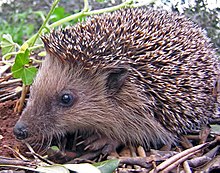Erinaceid
| Erinaceidae Temporal range: Eocene–Recent |
|
|---|---|
 |
|
| Erinaceus europaeus | |
| Scientific classification | |
| Kingdom: | Animalia |
| Phylum: | Chordata |
| Class: | Mammalia |
| Order: | Eulipotyphla |
| Family: |
Erinaceidae G. Fischer, 1814 |
| Subfamilies & Genera | |
Erinaceidae is a family in the order Eulipotyphla. Until recently, it was assigned to the order Erinaceomorpha, which has been subsumed with the paraphyletic Soricomorpha into Eulipotyphla. Eulipotyphla has been shown to be monophyletic; Soricomorpha is paraphyletic because Soricidae shared a more recent common ancestor with Erinaceidae than with other soricomorphs.
Erinaceidae contains the well-known hedgehogs (subfamily Erinaceinae) of Eurasia and Africa and the gymnures or moonrats (subfamily Galericinae) of South-east Asia. This family was once considered part of the order Insectivora, but that polyphyletic order is now considered defunct.
Erinaceids are generally shrew-like in form, with long snouts and short tails. They are, however, much larger than shrews, ranging from 10–15 cm in body length and 40-60 grams in weight, in the case of the short-tailed gymnure, up to 26–45 cm and 1-1.4 kilograms in the moonrat. All but one species have five toes in each foot, in some cases with strong claws for digging, and they have large eyes and ears. Hedgehogs possess hair modified into sharp spines to form a protective covering over the upper body and flanks, while gymnures have only normal hair. Most species have anal scent glands, but these are far better developed in gymnures, which can have a powerful odor.
Erinaceids are omnivorous, with the major part of their diet consisting of insects, earthworms, and other small invertebrates. They also eat seeds and fruit, and occasionally bird's eggs, along with any carrion they come across. Their teeth are sharp and suited for impaling invertebrate prey. The dental formula for erinaceids is: 2-3.1.4.33.1.2-4.3
...
Wikipedia
